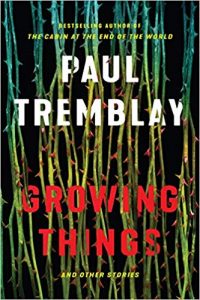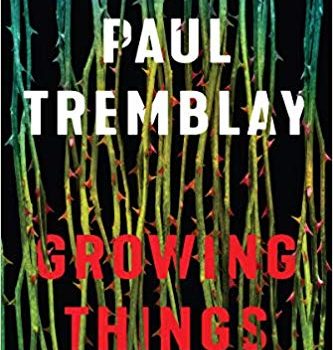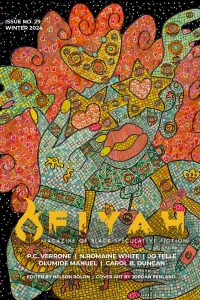Stefan Dziemianowicz Reviews Growing Things by Paul Tremblay
 Growing Things, Paul Tremblay (Morrow 978-0-06-267913-0, $25.99, 352pp, hc) July 2019.
Growing Things, Paul Tremblay (Morrow 978-0-06-267913-0, $25.99, 352pp, hc) July 2019.
Growing Things is Paul Tremblay’s latest short fiction collection, after Compositions for the Young and Old and In the Meantime, some of whose contents it shares. It’s also his first book after a trio of novels – A Head Full of Ghosts, Disappearance at Devil’s Rock, and The Cabin at the End of the World – that have placed him at the forefront of distinguished writers of contemporary horror fiction. It’s impossible not to detect resonances between the book’s 19 stories (two original to the volume), written over the past 15 years, and the novels written both after and around them, and it’s safe to say that readers who enjoy Tremblay’s novels are going to appreciate the dynamic the short stories share with them.
The tales that bookend the collection are outtakes of sorts from A Headful of Ghosts, both cast in the form of the freaky stories that Marjorie, the self-consciously tragic (and psychologically unbalanced) protagonist of that novel, tells her younger sister, Merry, its narrator. “The Thirteenth Temple”, the book’s closer, is a parable about inscrutable community rituals and insular social relationships that evokes the outsider themes of the fiction of Shirley Jackson, a strong influence on Tremblay’s novel. “Growing Things” is different – a story that incorporates Marjorie, Merry, and their mostly absent father into an apocalyptic scenario that may be occurring just beyond their front door. It’s one of several tales which foregrounds an intimate domestic drama against a vaguely suggested backdrop of widespread catastrophe – alluded to by a character in the story “_________” as “the world just ended, everyone disappeared or died or whatever, and all that’s left is us” (a reference that seems as good as touchstone as any for the plot of The Cabin at the End of the World). In “Swim Wants to Know if It’s as Bad as Swim Thinks”, this dynamic takes the form of the experiences of an emotionally distressed mother who abducts her child from custody to a refuge secure from an onslaught of rampaging monsters overrunning the landscape – all of which could be just be a figment of her delusional imagination. Tremblay’s most powerful story in this vein is “It’s Against the Law to Feed the Ducks”, a poignant, child’s-eye view of a pleasant family outing whose tenor changes drastically when something calamitous happens in the world beyond the vacation cottage and the parents have to put on perfect poker faces to shield their children from its enormity.
For several of the stories, Tremblay breaks the “fourth wall” of the narrative, drawing the reader intimately and ineluctably as a participant into the events by the tale’s end. In “Something About Birds”, the viewpoint character, a young enthusiast of horror fiction, interviews a reclusive writer and asks for a specific interpretation of the cryptic funeral procession that concludes his famous story of the same name. When the young man returns by invitation to a social gathering at the writer’s residence, he is unwittingly indoctrinated into a mysterious ritual that appears to bear out the darker implications of that funeral procession. “Nineteen Snapshots of Denisport” is related as a sequence of numbered captions for a series of photographs, each of whose images the story’s narrator describes for the reader’s benefit. As the images grow more and more portentous, the narrator scrambles the sequencing of one, eventually revealing that his is not an omniscient narrative voice, but rather one being addressed to a specific someone, whom he implicates in the story revealed by the photos, and whom he has called to account for them.
This story also shows Tremblay’s facility with segmented narratives. A number of the book’s selections are built from chapters or fragments that invite the reader to apply his or her own worst imaginings as the glue that stitches their pieces together. Tremblay presents this as subtly as the events in “The Teacher”, in which a beloved high school teacher exposes his students to images of pain and death from beyond the classroom walls and whose impact is gauged from degree of dysfunction and behavioral problems it breeds in those who view them, and as self-consciously as in “A Haunted House is a Wheel Upon Which Some Are Broken”, a clever interactive tour of a multiply haunted house which gives the reader the option to skip certain rooms and their ghosts, but with no chance of mitigating the story’s final horror. Tremblay pursues this approach to perfection in “Notes from the Dog Walkers”, presented as a series of notes left over a four-month span by a rotation of employees from a dog-walking service intended to reassure the owner of their fulfillment of their daily duties. The notes make up an amusing collage that gradually show each walker’s personality and the degree of his or her dedication–or ineptitude – at the job. One walker, though, who signs himself “KB,” is different: an individual who begins prying into the owner’s life through assumptions they make based on effects observed in the owner’s home, and whose insinuations imply that if said owner is not Paul Tremblay, then he’s a reasonable facsimile thereof, and that the walker feels astute enough a critic of literature, genre fiction, and the dog-owner’s own oeuvre, that he can teach him a thing or two about horror – whether he wants to learn it or not. It’s a tour-de-force of a fourth-wall breaking story, and KB’s cranky rants about genre writing and popular appraisals of horror fiction show the same critical insight that compelled Marjorie, in A Head Full of Ghosts, to subject her unwitting family to a nightmare experience distilled out of her personal familiarity with decades of contemporary horror fiction.
“Notes for ‘The Barn in the Wild”‘ – which appears to take its cue from Into the Wild, John Krakauer’s similarly titled non-fiction fiction book – is a magnificently eerie tale about an adventure writer (like Krakauer) researching the life of a young man who died under horrible circumstances in the wilderness (like Krakauer’s subject, Christopher McCandless) and who, in stumbling upon notes jotted by the young man about his experiences, seems on the verge of being seduced by the same cosmic forces that appear to have led the young man to his death. Tremblay wrote it for an anthology tribute to the fiction of fellow horror writer, Laird Barron, and it is one of several such stories selected from thematically specific anthologies to which he contributed, among them “Where We All Will Be” (for a tribute to the work of Thomas Ligotti), “Questions for the Somnambulist” (for a tribute to the film The Cabinet of Dr. Caligari), and “Her Red Right Hand” (for a tribute to Mike Mignola’s comic Hellboy). Tremblay’s willingness to work in the creative universes of other artists as well as his own, and to do it so well, says more about his versatility and fearlessness as a writer than any of the foregoing commentary can.
Stefan Dziemianowicz, Contributing Editor, is author of The Annotated Guide to Unknown and Unknown Worlds and a collection of re-told urban legends, Bloody Mary and Other Tales for a Dark Night, and editor (with S.T. Joshi) of three-volume reference work Supernatural Literature of the World: An Encyclopedia and of more than thirty anthologies including Bram Stoker Award-winning Horrors: 365 Scary Stories, Famous Fantastic Mysteries, and 100 Ghastly Little Ghost Stories. Between 1991 and 1999, he edited critical magazine Necrofile: The Review of Horror Fiction. His critical work on horror and fantasy fiction has appeared in Washington Post Book World, Lovecraft Studies, and other publications, and he is a regular contributor to Publishers Weekly.
This review and more like it in the September 2019 issue of Locus.
 While you are here, please take a moment to support Locus with a one-time or recurring donation. We rely on reader donations to keep the magazine and site going, and would like to keep the site paywall free, but WE NEED YOUR FINANCIAL SUPPORT to continue quality coverage of the science fiction and fantasy field.
While you are here, please take a moment to support Locus with a one-time or recurring donation. We rely on reader donations to keep the magazine and site going, and would like to keep the site paywall free, but WE NEED YOUR FINANCIAL SUPPORT to continue quality coverage of the science fiction and fantasy field.






